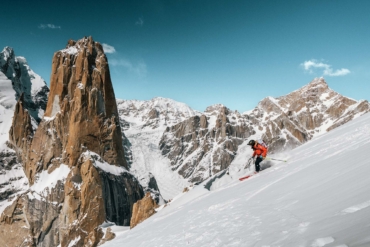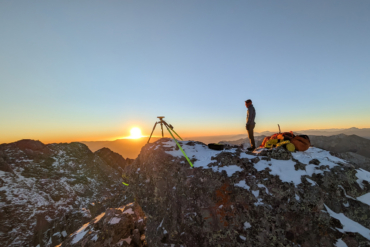When Adam Ondra speaks, Black Diamond listens. The result is the Black Diamond airNET Harness.
Black Diamond collaborated with rock climbing superstar Adam Ondra to develop a harness with a sole focus on weight reduction that could stand up to a performance at the Tokyo Olympics.
The result was the airNET Harness, released to the public last month. We tested an early sample during the fall and winter climbing season and came away impressed.
The (Really) Light Technology
Black Diamond pulled out all the stops to develop the airNET competition and sport climbing harness. Not only is it the lightest featured rock climbing harnesses on the market, but it also utilizes two patented technologies.
Our men’s size medium airNET sample weighed a verified 8 ounces, yet the harness isn’t completely bare-bones. The Black Diamond airNET Harness represents the tip of the spear in harness design, achieving a rare trifecta of super-low weight, comfort, and durability.
Black Diamond flexed the airNET patent to minimize weight while simultaneously improving function and comfort. The airNET is a Dynex net in the waist belt and leg loops — the open structure minimizes material and reduces weight. The net also spreads the load during a fall and facilitates maximum breathability; there is no additional padding or lining.

Another mass-cutting feature was inspired by Adam Ondra’s habit of cutting off the rear pair of gear loops to reduce bulk. Black Diamond took the hint and formed the rear pair of gear loops out of super-minimalist webbing. The front two gear loops are the more traditional pressure-molded variety.
Comfort & Durability: Up to Snuff
Many outdoor products that hold lightness above all else hugely sacrifice comfort — but not the airNet Harness. Black Diamond avoids the usual binding tape on the edges that contact the climber’s body; a seamless tape eradicates a potential source of skin irritation. And the brand’s patented Infinity belay loop cleverly avoids the usual overlap of webbing and bar tacks.
This construction provides uninterrupted surfaces for the entirety of the loop, eliminating the seam that can snag carabiners. Not only can this make belaying smoother, but it also removes the potential of gear popping over edges, which can be startling to both climber and belayer.
The tie-in points of a harness are usually the first places to show wear. So Black Diamond didn’t skimp in this area to save grams. Dynex wraps both tie-in points for abrasion resistance and stiffness (to ease rope threading). The airNET also uses a standard-sized buckle; no fussing with tiny buckles with seizing hands and painful fingertips.
Black Diamond’s airNET had a perceptible amount of breathability in the waist and leg loops, which I noticed when the humidity was high and a light breeze was present. In general, the harness felt light all around; the breathability certainly played a part.
A Minimalist Harness: Does It Work?
The men’s size medium airNET Harness fit my 6-foot-tall, 167-pound frame well. I had 9 inches of tail left on the waist adjustment (32-inch waist). And the non-adjustable, elasticized leg loops felt snug but comfortable on my 22.5-inch thighs.
Both waist belt and leg loops felt smooth against bare skin or thin layers. I wouldn’t categorize the feel as “soft,” as there’s no additional padding or lining, but it was comfortable while unloaded.
The airNET Harness in no way impeded movement. The non-adjustable elastic cord that anchors the rear of the leg loops felt too tight initially but stretched easily, and I soon forgot about it.
The amount of rise in the front felt correct for my anatomy. And the tapered profile of the waist loop never pinched or irritated me. In short, the harness became mostly unnoticeable.
I was paying extra attention to the Infinity belay loop while fifed into anchors. And my concern dissipated immediately, as there was no way to pop the seam — because there isn’t one. Kudos to Black Diamond for this innovation.
Lastly, my usual sport climbing zones have shorter routes, so I didn’t mind the minimalist webbing of the rear gear loops. The front loops worked fine; I found and removed quickdraws without pause or thought.
On falling: The best way to describe falling in the airNet Harness is that it was a non-issue. I fell on lead repeatedly, and I didn’t notice anything. I felt the same about hang-dogging for appropriate amounts of time in the airNET.
It’s not any more or less comfortable than other lightweight harnesses I’ve used or tested. That said, this isn’t an all-arounder harness; I wouldn’t want to hang for long periods or climb big walls with it. It’s strictly intended for sport or competition climbing.
Conclusions
The Black Diamond airNet Harness is an outstanding choice for sport climbing. Yes, it’s light, but it’s also comfortable for sport climbing and looks to be durable. The airNet technology performed as intended, and the Infinity belay loop provided a unique advantage.
I’ve used other sport climbing harnesses of the “has everything you need, nothing you don’t” ideology. They were safe and light, but there was always a noticeable negative: fussy main buckles, gear loops that didn’t stay open, or waist loops that chafed skin.
The Black Diamond airNET Harness avoided all these pitfalls of uber-light design. The takeaway is lightness without the usual drawbacks. Great job, Black Diamond.
The airNET Harness is available now for $160 in both men’s and women’s versions.








